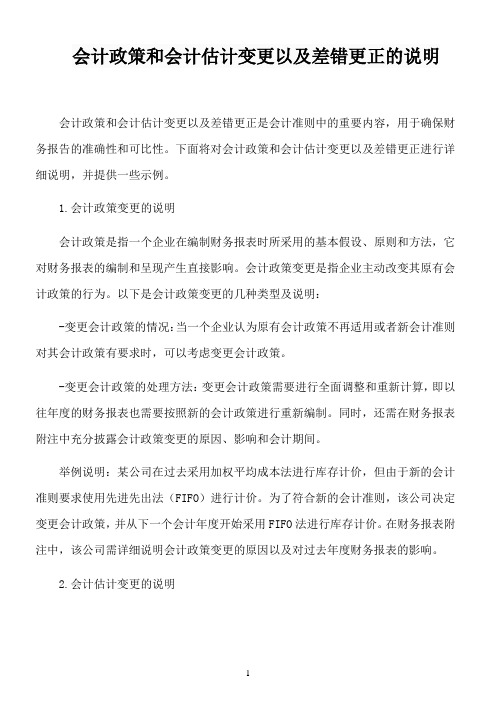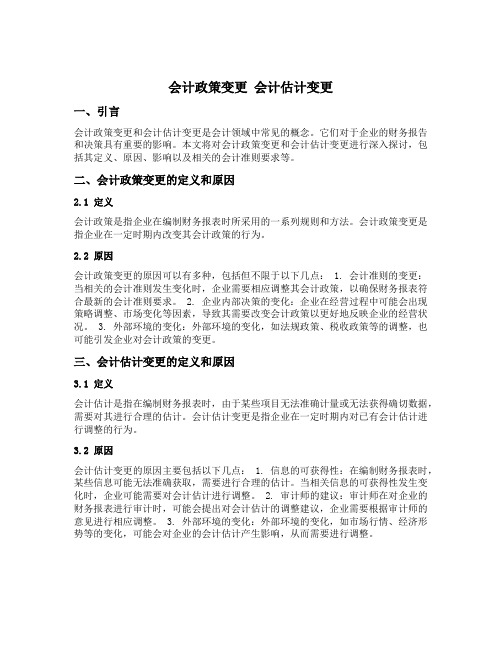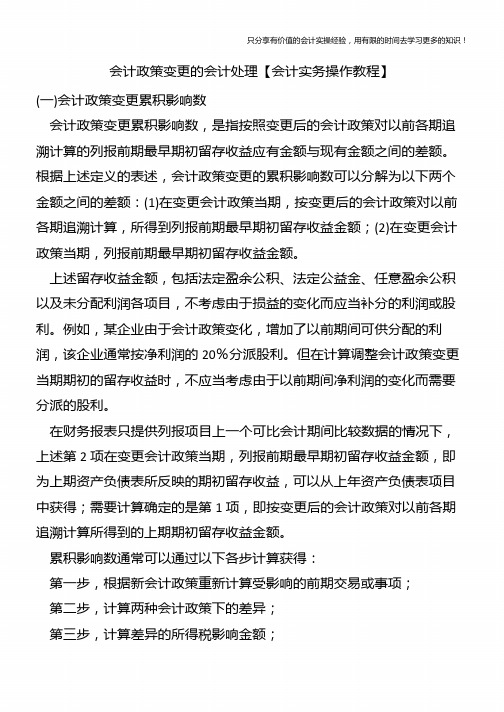会计政策变更
会计政策变更

策变更。有两种情况不属于会计政策变更的 范畴。
本期发生的交易或事项具有与以前不同的本质而 采用新的会计政策,不属于会计政策变更。
对初次发生的或不重要的交易或事项而采用新的 会计政策,也不属于会计政策变更。
二、会计政策变更的会计处理
会计政策涉及到会计原则、会计基础和具体的会 计处理方法。
企业的会计政策是组织会计核算的基础。 会计政策要保持相对的稳定性。 会计政策执行的相对灵活性。
一、会计政策与会计政策变更
企业会计政策的披露 在附注中予以披露的会计政策通常包括以下几个方面:
财务报表的编制基础、计量基础和会计政策的确定依据等。 合并政策。即在编制合并财务报表时所采纳的原则 外币折算政策。即将外币折算为人民币所采用的折算方法
和对汇兑损益的处理方法。 收入确认政策。即在确认收入时所采用的原则。 存货计价政策。即对存货计价所采用的原则。 长期股权投资的会计处理政策。即对长期投资所采用的核
算方法。 坏账损失的处理政策。即对坏账损失的会计处理方法。 借款费用处理政策。 其他会计政策。如无形资产的计价和摊销政策,长期待摊
计算会计政策变更的累积影响数; 根据累积影响数进行会计处理; 对会计报表相关项目进行调整; 在附注中予以说明。
二、会计政策变更的会计处理
累积影响数的计算程序 在运用追溯调整法的过程中,最关键的问题
是累积影响数的计算。累积影响数的计算按 下列程序进行:
按新的会计政策重新计算受影响的前期交易或事 项;
二是每一家企业在具体进行会计确认、计量和报告中所 遵循的具体原则,不同的企业可以根据本企业的实际情 况,在国家统一制定的企业会计准则或者企业会计制度 规定的范围内有选择地执行,因而具有特殊性。
会计政策变更浅析

会计政策变更,是指企业对相同的交易或者事项由原来采用的会计政策改用另一会计政策的行为。
为保证会计信息的可比性,使财务报表使用者在比较企业一个以上期间的财务报表时,能够正确判断企业的财务状况、经营成果和现金流量的趋势,一般情况下,企业采用的会计政策,在每一会计期间和前后各项应当保持一致,不得随意变更。
否则,势必削弱会计信息的可比性。
但是,在下述两种情形下,企业可以变更会计政策:第一,法律、行政法规或者国家统一的会计制度等要求变更。
这种情况是指,按照法律、行政法规以及国家统一的会计制度的规定,要求企业采用新的会计政策,则企业应当按照法律、行政法规以及国家统一的会计制度的规定改变原会计政策,按照新的会计政策执行。
例如,《企业会计准则第1号——存货》对发出存货计价排除了后进先出法,这就要求执行企业准则体系的企业按照新规定,交原来以后进先出法核算发出存货成本改为准则规定可以采用的会计政策。
第二,会计政策变更能够提供更可靠、更相关的会计信息。
由于经济环境、客观情况的改变,使企业原采用的会计政策所提供的会计信息,已不能恰当地反映企业的财务状况、经营成果和现金流量等情况。
在这种情况下,应改变原有会计政策,按变更后新的会计政策进行会计处理,以便对外提供更可靠、更相关的会计信息。
例如,企业一直采用成本模式对投资性房地产进行后续计量,如果企业能够从房地产交易市场上持续地取得同类或类似房地产的市场价格及其他相关信息,从而能够对投资性房地产的公允价值作出合理的估计,此时,企业可以将投资性房地产的后续计量方法由成本模式变更为公允价值模式。
对会计政策变更的认定,直接影响会计处理方法的选择。
因此,在会计实务中,企业应当正确认定属于会计政策变更的情形。
下列两种情况不属于会计政策变更:第一,本期发生的交易或者事项与以前相比具有本质差别而采用新的会计政策。
这是因为,会计政策是针对特定类型的交易或事项,如果发生的交易或事项与其他交易或事项有本质区别,那么,企业实际上是为新的交易或事项选择适当的会计政策,并没有改变原有的会计政策。
8-会计政策变更

第八章-会计政策变更、会计估计变更和差错更正(企业会计准则第28号)新旧准则比较会计政策变更一、会计政策的定义会计政策:是指企业在会计确认、计量和报告中所采用的原则、基础和会计处理方法。
的原则、基础和会计处理方法 企业应当对相同或者相似的交易或者事项采用相同的实务中某项交易或者事项如果没有相应具体会计准则或其应用指南加以规范的,应当根据或其应用指南加以规范的,应当根据《《企业会计准则————基本准则基本准则》》规定的原则、基础和方法进行处理;会计政策变更1、法律、行政法规或者国家统一的会计制度等要求变更变更。
2、会计政策变更能够提供更可靠、更相关的会计信息。
会计政策变更(二)不属于会计政策变更的事项1、本期发生的交易或者事项与以前相比具有本质差别而采用新的会计政策。
对初次发生的或不重要的交易或者事项采2、对初次发生的或不重要的交易或者事项采用新的会计政策。
会计政策变更三、会计政策变更的会计处理(一)会计政策变更的处理规定1、法定变更的,按照国家相关会计规定执行上市公司上市公司20072007年年1 1 月月1 1 日首次执行企业会计准则,日首次执行企业会计准则,准则及其解释规定进行处理首次执行企业会计准则》》及其解释规定进行处理,首次执行企业会计准则后发生的会计政策变更,应当根据本准则相关规会计政策变更三、会计政策变更的会计处理会变法(二)会计政策变更的处理方法1、追溯调整法:、追溯调整法:是指对某项交易或事项变更会计政、追溯调整法是指对某项交易或事项变更会计政策,视同该项交易或事项初次发生时即采用变更后计变更当期和未来期间确认会计估计变更影响数的方法。
三、会计政策变更的会计处理会计政策变更会计政策变更累积影响数,是指按照变更额之间的差额。
三、会计政策变更的会计处理会计政策变更(三)追溯调整法具体使用规定(分三个层次)2、具体使用规定(分三个层次)(1)将会计政策变更累积影响数调整列报前期最早期初留存收益。
(五)会计政策和会计估计变更以及差错更正的说明

会计政策和会计估计变更以及差错更正的说明会计政策和会计估计变更以及差错更正是会计准则中的重要内容,用于确保财务报告的准确性和可比性。
下面将对会计政策和会计估计变更以及差错更正进行详细说明,并提供一些示例。
1.会计政策变更的说明会计政策是指一个企业在编制财务报表时所采用的基本假设、原则和方法,它对财务报表的编制和呈现产生直接影响。
会计政策变更是指企业主动改变其原有会计政策的行为。
以下是会计政策变更的几种类型及说明:-变更会计政策的情况:当一个企业认为原有会计政策不再适用或者新会计准则对其会计政策有要求时,可以考虑变更会计政策。
-变更会计政策的处理方法:变更会计政策需要进行全面调整和重新计算,即以往年度的财务报表也需要按照新的会计政策进行重新编制。
同时,还需在财务报表附注中充分披露会计政策变更的原因、影响和会计期间。
举例说明:某公司在过去采用加权平均成本法进行库存计价,但由于新的会计准则要求使用先进先出法(FIFO)进行计价。
为了符合新的会计准则,该公司决定变更会计政策,并从下一个会计年度开始采用FIFO法进行库存计价。
在财务报表附注中,该公司需详细说明会计政策变更的原因以及对过去年度财务报表的影响。
2.会计估计变更的说明会计估计是指在财务报表编制过程中,由于某些交易或事件的结果尚未确定,需要根据可获得的信息和经验做出合理的估计。
会计估计变更是指企业在编制财务报表时对以前的会计估计进行修订。
以下是会计估计变更的几种类型及说明:-修订会计估计的情况:当相关信息或经验发生重大变化,或者企业认识到以前的估计存在错误或不准确时,可以考虑修订会计估计。
-修订会计估计的处理方法:修订会计估计需要在当前会计年度进行调整,并在财务报表附注中充分披露会计估计变更的原因、影响和会计期间。
举例说明:某公司在过去采用直线法对长期资产进行折旧,但由于资产的预计使用寿命发生变化,该公司决定修订折旧估计,并改为使用加速折旧法。
在财务报表附注中,该公司需详细说明会计估计变更的原因以及对当前会计年度和未来会计年度的财务报表的影响。
属于会计政策变更的情形

属于会计政策变更的情形一、会计政策变更的定义和作用会计政策变更是指企业在编制财务报表时,对原有的会计政策进行调整或改变的行为。
会计政策是企业为反映其财务状况、经营成果和现金流量,选择和应用一套准则、原则、基础和方法所形成的行为规范。
会计政策的选择和变更对企业的财务报表有着重要的影响,能够使报表更准确地反映企业的真实状况和经营成果。
二、会计政策变更的种类会计政策变更可以分为两类:会计估计变更和会计准则变更。
1. 会计估计变更会计估计是指企业在编制财务报表时,对于一些无法精确计量的事项,根据可得到的信息和经验做出的合理估计。
会计估计的变更常发生在每年末或在编制特定报表时,如重新计算无形资产的减值准备、存货的减值准备等。
会计估计变更的原因可能是企业经营环境的变化、会计政策的变更或者是企业发现之前的估计存在错误等。
企业进行会计估计变更时,需要对既往报表进行追溯调整,确保报表信息的连续性和一致性。
2. 会计准则变更会计准则是国家、地区或国际组织对于企业编制财务报表时所提出的规范和要求。
会计准则的变更通常由于国家法律法规的调整、会计准则的修订或者国际会计准则制定组织(IASB)发布了新的会计准则等原因。
会计准则变更的影响范围通常较大,会导致企业对原有会计政策进行重大调整或变更。
在面对会计准则变更时,企业需要及时调整自己的会计政策,确保财务报表符合最新的会计准则要求。
三、会计政策变更的原因和影响1. 会计政策变更的原因会计政策变更的原因包括但不限于以下几个方面:•法律法规的变化:国家法律法规对会计准则的要求发生变化,企业需要调整会计政策以符合最新的法律法规要求。
•审核机构或投资者要求:外部审计师或投资者要求企业采用特定的会计政策以提高财务报表的准确性和可比性。
•经营环境的变化:企业所处的经营环境发生了重大变化,旧有的会计政策无法满足公司经营需要,需要进行调整。
•错误或欺诈:企业发现之前的会计政策存在错误或欺诈行为,需要进行变更以修正错误。
会计政策变更及其条件

会计政策变更及其条件一、引言会计政策变更是指企业在编制财务报表时,对会计政策进行调整或更改的行为。
会计政策是企业在一定时期内编制财务报表所采用的基本假设、计量基础和核算方法的总和。
会计政策变更可能由于外部环境变化、会计准则更新或企业内部需要等原因而发生。
本文将详细探讨会计政策变更的条件以及其对财务报表的影响。
二、会计政策变更的条件会计政策变更需要满足一定的条件,包括以下几个方面:2.1 会计准则的变更会计准则是制定会计政策的基础,当会计准则发生变更时,企业需要相应地调整会计政策。
会计准则的变更可以由国家或地区的会计准则机构发布,也可以由国际会计准则组织(IASB)发布的国际财务报告准则(IFRS)引起。
企业在变更会计准则时,应遵循相关的法律法规和会计准则的规定,确保会计政策的合规性和准确性。
2.2 外部环境的变化外部环境的变化可能会导致企业需要调整会计政策。
例如,法律法规的改变、税收政策的调整、行业竞争格局的变化等都可能对企业的会计政策产生影响。
企业需要根据外部环境的变化,及时调整会计政策,以确保财务报表的准确性和可比性。
2.3 企业内部需要企业内部需要是会计政策变更的重要条件之一。
企业可能由于经营策略调整、组织结构变化、会计信息需求的变化等原因,需要调整会计政策。
例如,企业从传统制造业转型为服务型企业,会计政策可能需要调整以适应新的业务模式。
企业内部需要的变化是会计政策变更的重要动因,但变更会计政策需要慎重考虑,避免对财务报表的可比性和连续性造成不良影响。
三、会计政策变更的影响会计政策变更对财务报表的影响主要体现在以下几个方面:3.1 财务报表的可比性会计政策的变更可能导致财务报表的可比性降低。
企业在变更会计政策时,需要进行对比分析,评估变更前后的财务指标的变化情况,以便更好地理解财务报表的变化。
变更会计政策可能导致财务报表的数据不可比,给利益相关者的决策造成困扰。
3.2 财务报表的准确性会计政策变更对财务报表的准确性有一定影响。
会计政策变更

第三步,调整差异 差异=新政策-旧政策2006年末调整差异: 借:交易性金融资产——公允价值变动 20
贷:利润分配——未分配利润(公允价
值变动损益)20
考虑所得税影响:交易性金融资产产生暂时性 差异。
05年末暂时性差异=账面价值1 30-计税基础1
10=20(应纳税),应确认递延所得税负债5。
借:利润分配—未分配利润(所得税费用) 5
②利润表项目的调整(07年报表的上年数,即 06年金额):
调增公允价值变动收益上年金额20万元(只是 06年金额,不包括05年的60万)。其他项目同理。
③所有者权益变动表项目的调整(对照第12章 中的所有者权益变动表即表12-8):
注意:在所有者权益变动表中,“会计政策变 更”项目是“上年年末余额”大项目下的小项目。
贷:公允价值变动损益 60
第三步,调整差异 差异=新政策-旧政策,2005年末调
整差异:
借:交易性金融资产—公允价值变动60 贷:利润分配—未分配利润(公允价
值变动损益)60
考虑所得税影响:交易性金融资产产生暂时 性差异。
05年末暂时性差异=账面价值5 10-计 税基础4 50=60(应纳税),应确认递延所 得税负债15=60*25%。
二、会计政策变更 会计政策变更的两种情形:一是法规
要求变更;二是客观情况变化,变更能够 提供更加可靠相关的会计信息。
新事新政、不重要事项不属于会计政 策变更。
会计政策变更举例 常见的会计政策变更有:
①发出存货计价方法变更,比如,先进先出 法改为加权平均法。
②长期股权投资核算方法的变更,即,成本 法与权益法的转换。
第一,会计估计变更是关于不确定项目,而 会计政策变更是关于确定项目;
会计政策的选择与变更

会计政策的选择与变更在企业的财务报告中,会计政策的选择对于财务信息的准确性和可比性都至关重要。
会计政策是指企业在编制和报告财务信息时,为了满足法律法规和会计准则的要求,所做的一系列假设、方法和个别决策,从而对企业的财务状况、经营成果和现金流量产生影响。
一、会计政策的选择会计政策的选择涉及到许多方面,如收入确认、成本核算、资产计量等。
在选择会计政策时,企业应权衡各种因素,包括法律法规的要求、业内惯例、企业自身情况等。
以下是几个常见的会计政策选择问题:1. 收入确认政策:企业应根据实际销售或服务交付的情况,选择适当的收入确认政策。
例如,采用销售发生制,即在货物或服务交付给买方时确认收入;或采用完工百分比法,在项目完成的百分比达到一定比例时确认收入。
2. 存货计价政策:企业在计算存货成本时,可以选择先进先出法、后进先出法或加权平均法。
每种方法都会对存货的成本和利润产生不同的影响,企业应根据自身情况选择合适的方法。
3. 长期股权投资计量政策:企业在计算长期股权投资的价值时,可以选择使用成本法或权益法。
成本法即按照购买股权时支付的成本计量;权益法即按照所持股权对投资企业的净资产进行账面价值计量。
二、会计政策的变更在一些情况下,企业可能需要变更会计政策,例如法律法规变更、企业经营成果受到重大影响、会计准则更新等。
会计政策的变更应当遵循以下原则:1. 重大会计政策变更的披露:如果企业进行了重大的会计政策变更,应当在财务报告中进行明确的披露,并解释变更原因以及对财务报告的影响。
2. 会计政策的连续性:会计政策变更应当保持连续性,即相同的会计政策应当在连续的财务报告期间中应用。
如果变更会计政策后发现有错误或者需要调整,应当在变更时及时进行纠正。
3. 可比性的维持:企业应当确保会计政策的变更不会对财务信息的可比性产生重大影响。
如果变更会计政策会对可比性产生显著影响,企业应当提供额外的信息来解释变更对财务分析的影响。
会计政策变更对企业盈利能力的影响

会计政策变更对企业盈利能力的影响在企业的发展过程中,会计政策变更并不是一个罕见的现象。
会计政策的选择和变更对于企业的财务状况、经营成果以及盈利能力都有着重要的影响。
首先,我们需要明确什么是会计政策变更。
简单来说,会计政策变更就是企业对相同的交易或事项由原来采用的会计政策改用另一会计政策的行为。
这可能是由于会计准则的修订、企业经营环境的变化,或者是为了提供更可靠、更相关的财务信息等原因导致的。
会计政策变更会直接影响企业的资产、负债、收入、费用等会计要素的确认和计量,进而影响企业的盈利能力指标。
例如,存货计价方法的变更。
如果企业从先进先出法改为加权平均法,在物价持续上涨的情况下,会导致当期的销售成本增加,从而使得利润减少。
反之,如果在物价持续下跌时进行这样的变更,则会增加当期利润。
再比如,固定资产折旧方法的改变。
若从直线折旧法改为加速折旧法,前期的折旧费用会增加,从而减少当期利润;但从长期来看,固定资产的总成本在其使用寿命内是不变的,只是利润在不同期间的分布发生了变化。
企业坏账准备计提比例的调整也是常见的会计政策变更。
提高坏账准备计提比例会增加当期的资产减值损失,减少利润;降低计提比例则会有相反的效果。
会计政策变更对企业盈利能力的影响还体现在对投资者和债权人决策的影响上。
如果企业频繁地进行会计政策变更,或者变更的理由不充分、不透明,可能会让投资者和债权人对企业的财务报告产生怀疑,降低对企业的信任度,进而影响企业的融资能力和股价表现。
此外,会计政策变更也可能影响企业的税收。
不同的会计政策可能导致企业应纳税所得额的不同,从而影响企业的税负。
例如,某些费用的资本化或费用化处理方式的不同,会影响当期应纳税所得额和应交所得税的金额。
然而,并非所有的会计政策变更都是为了操纵利润。
有些变更确实是为了更好地反映企业的经济实质和经营成果。
例如,当企业的业务模式发生重大变化时,相应地调整会计政策可以提供更准确的财务信息。
了解会计政策的变更与解读

了解会计政策的变更与解读在企业的财务报告中,会计政策的变更是一个常见的现象。
这种变更可能是由于法律法规的改变、公司经营策略的调整或者会计准则的更新等原因引起的。
了解会计政策的变更对于投资者、分析师和其他利益相关者来说至关重要,因为它可以影响到财务报告的可比性和准确性。
本文将探讨会计政策的变更和如何解读这些变更。
首先,会计政策的变更可以分为主动变更和被动变更两种类型。
主动变更是指企业自愿选择改变会计政策,而被动变更是指企业由于外部原因不得不改变会计政策。
主动变更可能是为了更好地反映企业的经济状况和业绩,或者是为了遵守新的会计准则。
被动变更可能是由于法律法规的改变、税收政策的调整或者公司经营策略的调整等原因引起的。
在解读会计政策的变更时,首先需要了解变更的原因和目的。
企业在财务报告中通常会披露会计政策的变更原因和目的。
这些信息可以帮助我们理解为什么会计政策发生了变更以及变更的影响。
例如,如果企业选择了新的会计政策以更好地反映其经济状况和业绩,那么我们可以认为这是企业对财务报告透明度的提升和财务信息的更准确披露。
其次,需要注意会计政策变更对财务报告的影响。
会计政策的变更可能会对企业的财务报告产生重大的影响,特别是对财务指标和财务比率的计算。
例如,企业从使用加速折旧法改为使用直线折旧法,这将导致企业的固定资产净值和折旧费用发生变化,进而影响到企业的利润和资产负债表等财务报表。
因此,在解读会计政策的变更时,需要对变更的具体影响进行综合分析,以便更准确地评估企业的财务状况和业绩。
此外,还需要关注会计政策变更的时机和频率。
会计政策的变更时机和频率可能会对投资者和分析师产生误导。
如果一个企业频繁地变更会计政策,那么投资者和分析师可能会对其财务报告的可比性和稳定性产生怀疑。
因此,当解读会计政策的变更时,需要考虑变更的时机和频率是否合理,并结合其他信息进行综合分析。
最后,需要了解会计政策变更的后续影响。
会计政策的变更可能会对企业的未来经营和财务状况产生长期影响。
会计政策变更的理由

会计政策变更的理由会计政策变更是企业在管理过程中根据实际需要对会计处理方法和原则做出的调整和改变。
会计政策变更的理由可以有很多,下面我将从以下几个方面进行详细阐述。
一、法律、法规和会计准则的变更要求会计政策变更的一个重要理由是法律、法规和会计准则的变更要求。
由于法律和法规的修订或者会计准则的更新,企业可能需要对旧的会计政策进行调整或者更换,以符合新的要求和规定。
例如,2017年公布的新修订的《企业会计准则》对所有企业的会计处理方法和原则提出了新的要求,如果企业之前的会计政策与新的准则不符,就需要进行调整。
二、企业运营特点和模式的变化企业运营特点和模式的变化也是会计政策变更的常见理由。
随着企业的发展和扩大,企业的运营特点和模式可能会发生变化,导致原有的会计政策无法完全适应现有的情况。
例如,企业从传统的线下销售模式转变为线上销售模式,就需要对销售收入的确认和会计处理方法进行调整。
三、经济和商业环境的变化经济和商业环境的变化也是会计政策变更的动因之一。
随着经济的发展和社会的进步,企业在面对新的经济和商业环境时,也需要对会计政策进行调整。
例如,某些行业的产品或服务的市场价格、供需关系、竞争程度等因素发生变化,企业就需要对相关会计政策进行调整,以准确反映实际情况。
四、企业自身经营需要和目标的变化企业自身经营需要和目标的变化也是会计政策变更的一个重要理由。
随着企业的经营环境和经营策略的变化,会计政策可能需要做出相应调整,以更好地适应企业的经营需要和目标。
例如,企业可能在某个阶段更注重盈利能力,在另一个阶段更注重市场份额,这就需要对会计政策进行调整,以反映企业的真实经营情况。
五、财务信息的准确性和可比性的要求财务信息的准确性和可比性要求也是会计政策变更的一个重要考虑因素。
当企业发现原有的会计政策无法准确反映企业的财务状况和经营成果,或者无法与其他企业的财务信息进行比较时,就需要对会计政策进行变更。
例如,某个准则的会计政策可能会使企业的负债水平和收入水平看起来偏高或偏低,这时企业就需要对会计政策进行调整,以保证财务信息的准确性和可比性。
会计政策变更的定义

会计政策变更的定义
会计政策变更的定义是指公司或组织在编制财务报表时,根据特定的原则和准则,对会计政策进行调整或更改的过程。
会计政策是指公司或组织在编制财务报表时所采用的一系列规定、原则和方法,用于识别、衡量、报告和披露财务信息。
会计政策变更可能是出于多种原因,如法律法规的变化、产业环境的变动、公司策略的调整等。
变更会计政策需要明确的决策过程和明确的理由,同时需要进行适当的披露,以确保财务报表的准确性和透明度。
会计政策变更的影响通常在财务报表中体现。
例如,变更会计政策可能导致资产、负债、收入或费用的重新计量、重分类或重新确认。
这些变化可以对财务报表中的指标如利润总额、资产负债表和现金流量表产生重要的影响。
根据国际财务报告准则(IFRS)和美国通用会计准则(US GAAP),会计政策变更一般分为主动变更和被动变更。
主动变更是指公司主动决定改变会计政策,并对之前的财务报表进行重新计算和调整。
被动变更则是因外部因素导致会计政策发生变化,公司只需要在财务报表中进行相应的披露。
总而言之,会计政策变更是会计实践中一项重要的过程,其目的是确保财务报表反映真实和公允的财务状况和业绩。
变更会计政策需要经过周详的考虑和决策,并进行适当的披露,以保持财务报表的可比性和透明度。
会计政策变更调减年初留存收益分录

会计政策变更调减年初留存收益分录一、引言在企业会计中,会计政策变更是指企业在编制财务报表时,对会计政策的选择、变更或者放弃的行为。
会计政策变更可能涉及到对年初留存收益的调整,本文将就该主题展开深入探讨。
二、会计政策变更的背景会计政策变更是企业在特定情况下对会计政策进行调整的必要行为。
企业可能会因为各种原因,如法律法规的变化、会计准则的修订、经营环境的变化等,需要对会计政策进行调整。
这种调整可能会对财务报表产生重大影响,特别是对年初留存收益的计算和披露。
三、会计政策变更的原因会计政策变更的原因多种多样,下面列举几个常见的原因:1. 会计准则的变化当会计准则发生变化时,企业可能需要对其会计政策进行相应调整。
新的会计准则可能会对特定会计处理方式提出新的要求,企业需要按照新的要求进行会计政策的变更。
2. 经营环境的变化企业的经营环境可能会发生变化,例如市场竞争加剧、行业政策调整等。
这些变化可能会对企业的会计政策产生影响,企业可能需要调整会计政策以适应新的经营环境。
3. 公司合并、分立或重组当企业发生合并、分立或重组等重大变革时,会计政策往往需要进行相应的调整。
这是因为企业的规模、业务结构等发生了重大变化,原有的会计政策可能无法适应新的情况。
四、会计政策变更对年初留存收益的影响会计政策变更可能对年初留存收益产生影响,主要体现在以下几个方面:1. 会计政策变更的影响会计政策变更会对财务报表中的各项指标产生影响,包括年初留存收益。
变更前后的会计政策可能对收入、费用、资产、负债等方面的计量和确认产生影响,进而影响年初留存收益的计算。
2. 调减年初留存收益分录的编制根据会计准则的规定,当会计政策变更对年初留存收益产生重大影响时,企业应当通过调减年初留存收益的方式进行披露。
具体的分录编制需要根据变更前后的会计政策差异进行计算,以确保财务报表的准确和可比性。
五、会计政策变更调减年初留存收益分录的计算方法会计政策变更调减年初留存收益的分录计算方法如下:1.首先,需要确定会计政策变更前后的差异。
专题八 会计政策变更、差错更正及资产负债表日后事项

专题八会计政策变更、差错更正及资产负债表日后事项回顾二、编制相关项目的调整分录三、调整列报前期最早期初财务报表相关项目及其金额四、会计政策变更的附注说明1.会计政策变更的性质、内容和原因。
包括:对会计政策变更的简要阐述、变更的日期、变更前采用的会计政策和变更后所采用的新会计政策及会计政策变更的原因。
2.采用追溯调整法时,计算出的会计政策变更的累积影响数;当期和各个列报前期财务报表中需要调整的净损益及其影响金额,以及其他需要调整的项目名称和调整金额。
3.无法进行追溯调整的,说明该事实和原因以及开始应用变更后的会计政策的时点、具体应用情况。
包括:无法进行追溯调整的事实;确定会计政策变更对列报前期影响数不切实可行的原因;在当期期初确定会计政策变更对以前各期累积影响数不切实可行的原因;开始应用新会计政策的时点和具体应用情况。
案例——会计政策变更甲公司20×5年、20×6年分别以4 500 000元和1 100 000元的价格从股票市场购入A、B两只以交易为目的的股票(假设不考虑购入股票发生的交易费用),市价一直高于购入成本。
公司采用成本与市价孰低法对购入股票进行计量。
公司从20×7年起对其以交易为目的购入的股票由成本与市价孰低改为公允价值计量,公司保存的会计资料比较齐备,可以通过会计资料追溯计算。
假设所得税税率为25%,公司按净利润的10%提取法定盈余公积,按净利润的5%提取任意盈余公积。
公司发行股票为4 500万股。
两种方法计量的交易性金融资产账面价值如下表所示:两种方法计量的交易性金融资产账面价值单位:元成本与市价孰低20×5年年末公允价值20×6年年末公允价值A股票 4 500 000 5 100 000 5 100 000B股票 1 100 000 - 1 300 000根据上述资料,甲公司的会计处理如下:案例分析1.计算改变交易性金融资产计量方法后的累积影响数,如下表所示:改变交易性金融资产计量方法后的累积影响数单位:元时间公允价值成本与市价孰低税前差异所得税影响税后差异20×5年末 5 100 000 4 500 000 600 000 150 000 450 00020×6年末 1 300 000 1 100 000 200 000 50 000 150 000合计 6 400 000 5 600 000 800 000 200 000 600 0002.调整分录对20×6年有关事项的调整分录:对20×5年及以前有关事项的调整分录:3.财务报表调整和重述甲公司在列报20×7年财务报表时,应调整20×7年资产负债表有关项目的年初余额、利润表有关项目的上年金额及所有者权益变动表有关项目的上年金额和本年金额。
会计政策变更条件(一)

会计政策变更条件(一)会计政策变更条件背景概述会计政策是指企业在编制财务报表过程中所应遵循的一系列准则和规定。
在特定情况下,企业可能需要根据实际情况调整其会计政策。
本文将介绍一些常见的会计政策变更条件。
1.全球会计准则变更全球会计准则的不断更新和修订是会计政策变更的一个重要条件。
全球会计准则组织(IASB)定期发布新的会计准则,以适应不断变化的商业环境和法规要求。
企业需要密切关注全球会计准则的变动,并确保其会计政策与新的准则保持一致。
2.法规要求变更受国家、地区或行业的法规要求变更影响,企业在编制财务报表时可能需要调整其会计政策。
例如,国家税务局调整了企业所得税的计算方法,企业就需要相应地调整其会计政策,以确保税务申报和财务报表的一致性。
3.业务结构变更企业业务结构的变更也可能引起会计政策的调整。
当企业进行重大收购、合并、分立或资产置换等交易时,会计政策需要根据新的业务形态进行调整。
例如,在合并过程中,企业需要确定并采用一种一致的会计政策,以便比较新旧业务的财务表现。
4.会计政策选择变更随着企业运营环境的变化,企业可能需要根据其经营和财务需求来调整会计政策。
例如,企业最初采用实物计量法进行固定资产估计,但随着技术的进步,可能转而采用重新评估法进行计价。
这种变更需要与利益相关方充分沟通,并进行必要的财务和税务处理。
结论会计政策的变更是企业财务报表编制过程中的一项重要工作。
企业需要密切关注全球会计准则的变动、法规要求的变更、业务结构的调整以及会计政策的选择变更。
确保会计政策的科学适用和合规性,有助于提高财务报表的准确性和透明度,增强企业的可持续发展能力。
常见的会计政策变更条件还有以下几点:5.业务策略调整企业的业务策略调整可能导致会计政策的变更。
例如,企业决定扩大国际市场的业务,可能需要调整外币折算会计政策。
这样可以确保其财务报表准确反映国际业务的经济影响。
6.反映经济现实会计政策的变更可以帮助企业更准确地反映其经济现实。
会计政策变更 会计估计变更

会计政策变更会计估计变更一、引言会计政策变更和会计估计变更是会计领域中常见的概念。
它们对于企业的财务报告和决策具有重要的影响。
本文将对会计政策变更和会计估计变更进行深入探讨,包括其定义、原因、影响以及相关的会计准则要求等。
二、会计政策变更的定义和原因2.1 定义会计政策是指企业在编制财务报表时所采用的一系列规则和方法。
会计政策变更是指企业在一定时期内改变其会计政策的行为。
2.2 原因会计政策变更的原因可以有多种,包括但不限于以下几点: 1. 会计准则的变更:当相关的会计准则发生变化时,企业需要相应调整其会计政策,以确保财务报表符合最新的会计准则要求。
2. 企业内部决策的变化:企业在经营过程中可能会出现策略调整、市场变化等因素,导致其需要改变会计政策以更好地反映企业的经营状况。
3. 外部环境的变化:外部环境的变化,如法规政策、税收政策等的调整,也可能引发企业对会计政策的变更。
三、会计估计变更的定义和原因3.1 定义会计估计是指在编制财务报表时,由于某些项目无法准确计量或无法获得确切数据,需要对其进行合理的估计。
会计估计变更是指企业在一定时期内对已有会计估计进行调整的行为。
3.2 原因会计估计变更的原因主要包括以下几点: 1. 信息的可获得性:在编制财务报表时,某些信息可能无法准确获取,需要进行合理的估计。
当相关信息的可获得性发生变化时,企业可能需要对会计估计进行调整。
2. 审计师的建议:审计师在对企业的财务报表进行审计时,可能会提出对会计估计的调整建议,企业需要根据审计师的意见进行相应调整。
3. 外部环境的变化:外部环境的变化,如市场行情、经济形势等的变化,可能会对企业的会计估计产生影响,从而需要进行调整。
四、会计政策变更和会计估计变更的影响4.1 对财务报表的影响会计政策变更和会计估计变更对财务报表的影响是显著的。
会计政策变更可能导致财务报表中各项指标的变化,如利润总额、资产负债表的项目等。
会计政策变更的会计处理【会计实务操作教程】

在某些情况下,调整一个或者多个前期比较信息以获得与当期会计信 息的可比性是不切实可行的。例如,某个或者多个前期财务报表有关项 目的数据难以收集,而要再造会计信息则可能是不切实可行的。
对根据某项交易或者事项确认、披露的财务报表项目应用会计政策时 常常需要进行估计。本质上,估计是主观行为,而且可能在资产负债表 日后才做出。当追溯调整会计政策变更或者追溯重述前期差错更正时, 要做出切实可行的估计更加困难,因为有关交易或者事项已经发生了较 长一段时间,要获得做出切实可行的估计所需要的相关信息往往比较困 难。
只分享有价值的会计实操经验,用有限的时间去学习更多的知识!
会计政策变更的会计处理【会计实务操作教程】 (一)会计政策变更累积影响数
会计政策变更累积影响数,是指按照变更后的会计政策对以前各期追 溯计算的列报前期最早期初留存收益应有金额与现有金额之间的差额。 根据上述定义的表述,会计政策变更的累积影响数可以分解为以下两个 金额之间的差额:(1)在变更会计政策当期,按变更后的会计政策对以前 各期追溯计算,所得到列报前期最早期初留存收益金额;(2)在变更会计 政策当期,列报前期最早期初留存收益金额。
上述留存收益金额,包括法定盈余公积、法定公益金、任意盈余公积 以及未分配利润各项目,不考虑由于损益的变化而应当补分的利润或股 利。例如,某企业由于会计政策变化,增加了以前期间可供分配的利 润,该企业通常按净利润的 20%分派股利。但在计算调整会计政策变更 当期期初的留存收益时,不应当考虑由于以前期间净利润的变化而需要 分派的股利。
- 1、下载文档前请自行甄别文档内容的完整性,平台不提供额外的编辑、内容补充、找答案等附加服务。
- 2、"仅部分预览"的文档,不可在线预览部分如存在完整性等问题,可反馈申请退款(可完整预览的文档不适用该条件!)。
- 3、如文档侵犯您的权益,请联系客服反馈,我们会尽快为您处理(人工客服工作时间:9:00-18:30)。
/
中华会计网校会计人的网上家园
会计政策变更
ACCA P2考试:Changes in Accounting Policy
A change in accounting policy only can be made if:
required by an IFRS or IFRIC (i.e. a mandatory change); or
it would result in the finan cia l statements providing more relevant and reliable information (i.e. a voluntary change).
As users of financial statements will wish to see trends in an entity's financial statements, it would not be appropriate for an entity to change its accounting policy whenever it wishes.
If an entity decides to adopt the revaluation model of IAS 16 Property, Plant and Equipment, this would be classified as a change in accounting policy.
If a new IFRS is issued, the transitional provisions of that standard will be applied to any change of accounting policy. When IFRS 11 Joint Arrangements was issued it did not allow the use of proportionate consolidation, so the transition statement explains how to change from a policy of proportionate consolidation to a policy of equity accounting.
If a new standard does not have transitional provisions, or it is a voluntary change, the entity must apply the change in policy retrospectively.
Retrospective application means adjusting the opening balance of each affected part of equity for the earliest period presented and the comparative amounts disclosed for each prior period as if the new policy had always been applied.
If it is not practicable to apply the effects of a change in policy to prior periods then the change of policy is made from the earliest period for which retrospective application is practicable.
IAS 1 requires an entity to include an additional statement of financial position (i.e. three statements must be presented) whenever it changes an accounting policy.。
